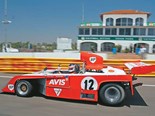Flashback: Elfin Clubman T5 vs Caterham SVR 200 comparo













































|

|

|

|

|

|

|

|

|

|

|

|

|

|

|

|

|

|

|

|

|

|
Australia takes on England in a battle of modern, bare-bone road racers
From Unique Cars #297, April 2009
Elfin vs Caterham
Two wheelers rave about the connectivity between bike, body and bitumen, but it’s the likely contact between the latter two that keeps my bum firmly planted on all fours.
Yet there’s an undeniable rush in being exposed to the elements, seeing the rubber squirm and smelling the flowers and the fear, that conventional sports cars – even the most dynamic new kerb cruisers – just don’t deliver.
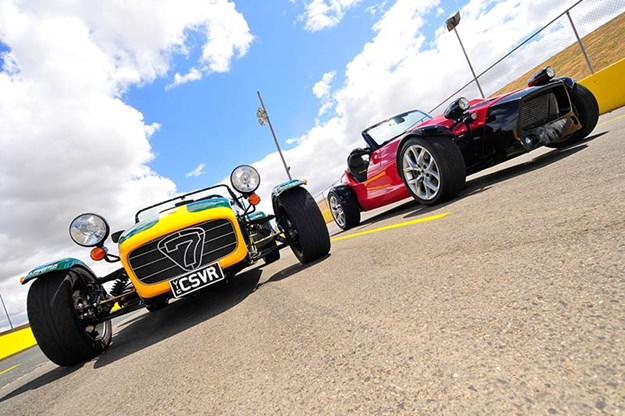
Colin Chapman didn’t have such café latte concepts in mind when he launched his liberating Lotus 7 at the London Motor Show in 1957. Low-cost, high performance through simplicity and low weight were Chapman’s dictums and more than five decades later, these values have largely survived in the 7’s 21st Century incarnations.
| Read next: 2016 Caterham Seven 485S review
Adelaide’s Garrie Cooper successfully translated Chapman’s concept into the Elfin Clubman introduced in 1961, while in 1973 Caterham Cars acquired the rights to build the Lotus 7. Yet while various other makers like Britain’s Westfield and Sydney’s PRB all offer clubman-style cars in kit or turnkey form, the needle match between the original players, Lotus (Caterham) and Elfin, remains.
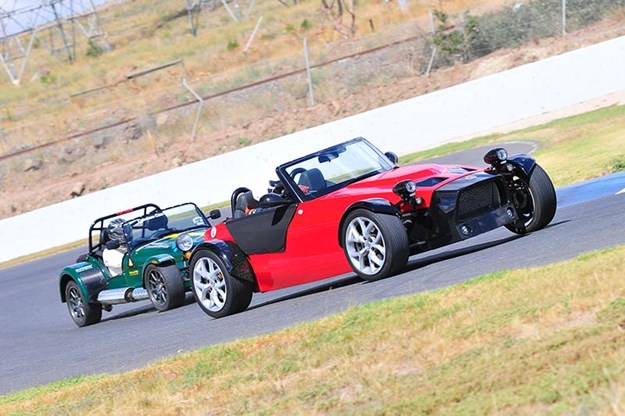
Red Elfin is an easier all-round proposition to live with, but little between them on the track
Back to the Four
Caterham has never wavered from its core business over the past 36 years and its range of four cylinder-engined clubman cars that sell like hen’s teeth in Australia remain the essence of the Chapman idea.
Elfin, on the other hand, has driven a rockier road. Production of road cars effectively stopped on Cooper’s death in 1982 and only resumed in 1997 after the business was purchased and transferred to Melbourne by businessmen and historic racing enthusiasts Bill Hemming and Nick Kovatch.
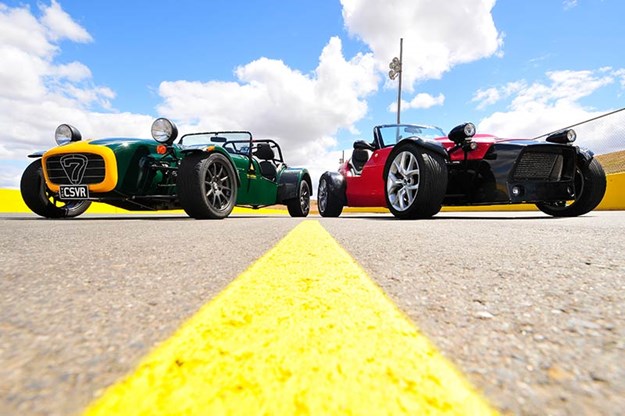
They revived the Clubman concept a year later, with the four-cylinder C3 selling more than 70 in naturally-aspirated and supercharged form before production was halted in 2007 because its Toyota 4AGE engine no longer complied with emission laws. The C3’s successor was due to be the current MS8 Clubman and its sleek Streamliner alter ego, with Holden design guru Mike Simcoe’s emotive styling of both models based around similar square-tube chassis dimensions and a four-pot powerplant. But enthused and flattered by Holden’s new arm-around-shoulder interest, Hemming and Kovatch agreed to shoe-horn a Chevrolet LS1 5.7-litre V8 into the engine bay instead.
As a result, when Walkinshaw Performance purchased Elfin in 2006, it found itself without a four-cylinder Clubman in the pipeline. That mightn’t have been such a problem except there were issues with the MS8 models and even prior to the current economic downturn, there was a retreat from V8-engined sports cars.
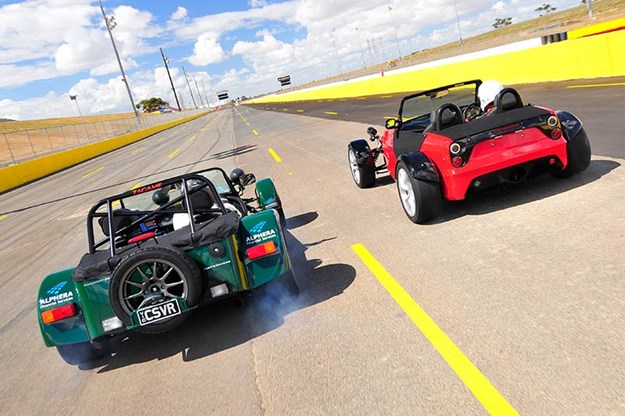
Lighting up the rears is easy in both cars! Both clubmans would make ideal track day giant-killers
Being based on the old C3’s dimensions, the MS8’s cockpit was narrow and squeezy for larger folk, something that new Elfin Sports Cars’ ex-HSV General Manager John Clark (height 193cm, weight 120kg, shoe size 13) discovered immediately. Just as significantly, the narrow structure also limited the amount of GM-sourced equipment that could be accommodated, most notably the power steering that MS8 owners cried for.
Finally, there was a groundswell of demand from many previous and potential Elfin customers for a traditional four-cylinder model at a somewhat cheaper price than the circa-$100k required for the V8 MS8s.
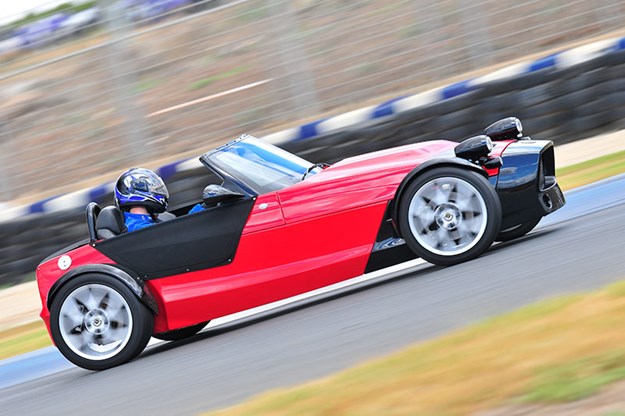
Faced with these obstacles, Walkinshaw Performance bit the bullet and took the opportunity to completely redesign the Clubman for the 21st century. The result is called the Type 5, signifying the fifth generation of the two-seater sports car since Cooper’s original nearly five decades ago. It doesn’t replace the MS8 models, which will still trickle on to customer order at the rate of around one a month, but it’s the future according to John Clark, who can now happily drive a company car.
In ya face!
For those accustomed to skimpy alloy panels that could be (and often were) fashioned over the knee of an artisan, combined with classic Lotus 7 looks, the new Elfin looks a little radical at first acquaintance.
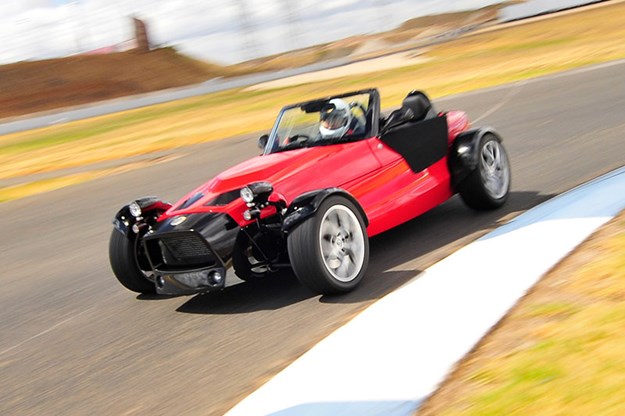
760kg Elfin provides ‘slingshot’ performance from its 2.0-litre turbo engine and it corners well too!
Julian Quincey’s in-house designed GRP (Glass Reinforced Plastic) bodywork is wide and racy, while the projector-style headlights, streamlined mirrors and LED rear lamp cluster are very much from the current styling text-book.
Inside, fellow HSV designer Adam Dean Smith eschewed the aftermarket instrument array much loved by Lotus 7 devotees and instead created a car-like cockpit complete with a sculptured GRP dashpad, hooded instruments (optional eye-watering yellow on the test car), flow-through ventilation and even a centre console. Sir Colin would have cringed!
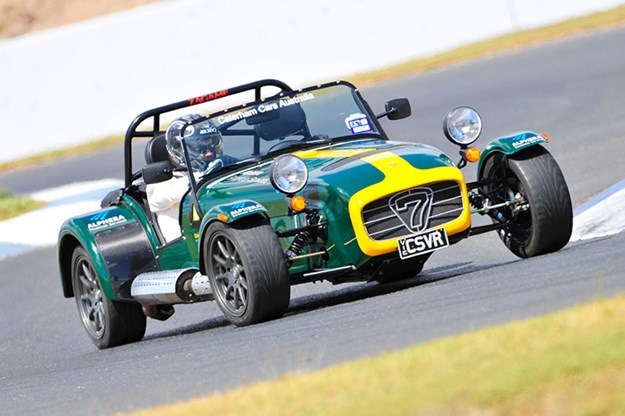
Caterham has more conventional Clubman styling but 2.3-litre four endows it with thoroughly modern performance
But it’s the extra width delivered by the new and lighter round-tube frame that makes all the difference to the Type 5’s daily drivability. Not only will the car now accommodate a much wider range of human beings, but also more Holden componentry. At just 30mm narrower overall than a VE Commodore, it happily accepts the late 1990 model’s power steering, while the T5’s differential, drive shafts and brakes come from the current VE range.
Up front under the clever forward hinged bonnet, there’s another member of the global GM family – an all-alloy, Gen II Ecotec, 2.0-litre, four cylinder, direct injection, variable valve timing gem borrowed from the Pontiac Solstice that with the aid of a twin-scroll turbo and intercooler huffs out a euphoric 194kW and 351Nm.
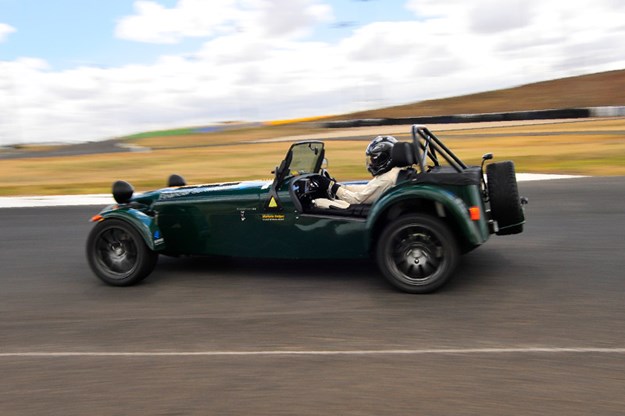
Bolt on a slick five-speed manual gearbox, fit fully independent wishbone and coil over shocker suspension on each corner, add large ventilated disc brakes all round and sharp power-assisted steering and you have all the ingredients for an engaging drive at a starting price of $64,950. ‘Ours’ with its optional leather seats, yellow dash instruments, and larger 17-inch alloys, would have owed around $75,000.
Although Clark rates the basic T5 as "50 per cent street car and 50 per cent track car", the Clubman is entirely habitable and docile as a lamb when it needs to be.

You jiggle yourself into the shapely (optional) leather-clad bucket seats under the flat bottom steering wheel and find many familiar controls and switchgear, with the stubby gearshift and central handbrake able to be used enthusiastically without sexually assaulting your passenger.
Vision through the large, flat and relatively upright windscreen is excellent and even without side-screens or deflectors, wind-buffeting is moderate. With its independent suspension all round, the T5’s ride is also remarkably compliant, with even sharp road divisions absorbed without a spinal tap. I recall past clubman-type cars I have driven and miss none of their discomfort!

We trickle through traffic, never needing to work the engine above 4000rpm and arrive unruffled at Melbourne’s Calder Raceway, where we meet Caterham Cars Australia’s Chris Van Wyk with the T5’s sparring partner for our photoshoot – the SVR 200.
Clubman DNA
There are some cars that just look ‘right’ from first glance and the SVR 200 is one of them. Visually it has strong emotional links to the original Lotus 7, with its front wheel mounted cycle mudguards, round ‘frog’ eye headlights, alloy bodywork and menacing driver’s side exhaust. I had driven its similar-looking predecessor, the Caterham HPC, some years ago and my mind still tingled from the experience.
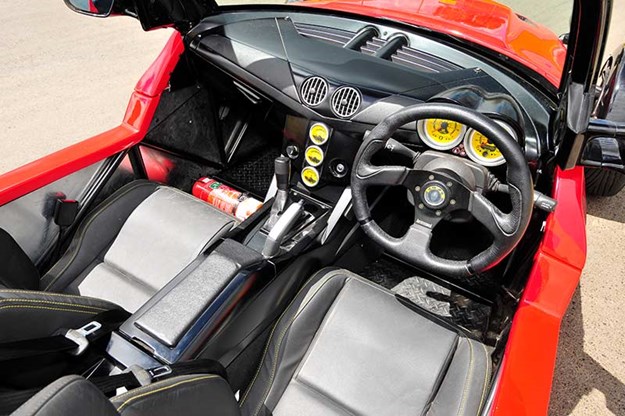
Two-seat cockpit is built for big, burly blokes. Bling in the form of yellow gauges, leather and 17-inch alloys are optional extras
But the SVR 200 promised even more. Powered by a hand-built, naturally-aspirated 2.3-litre Duratec dry-sump engine producing 147kW thanks to Cosworth internals, cylinder heads, inlet manifold and ECU, its race-bred spec also included a lightened flywheel, six-speed close ratio gearbox, and a Quaife limited slip differential.
On top of its $119,000 base price, Van Wyk’s SVR 200 was also ordered with various options, including Track Day cross-bracing for the roll cage, special paint, larger ventilated front disc brakes and a spare wheel – something yet to appear on the Elfin T5 catalogue!
Although you can still order one, the SVR 200 is soon being replaced in the Australian Caterham catalogue with the $10,000 dearer CSR 200, which features similar drivetrain specs, but has entirely new inboard front and fully independent rear suspension, compared to the SVR’s De Dion semi-independent rear end.
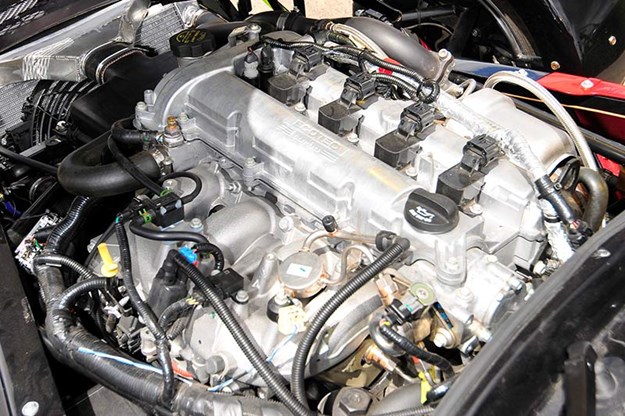
As I was already adjusted to it, I sample the T5 first on the circuit and immediately find its inner beast. ‘Slingshot’ is the word that comes to mind as the twin-scroll turbo running at 1.4 bar cuts in, forcing a hasty grab for the gear lever in the lower gears to avoid hitting the limiter.
Five gears may be yesterday’s numbers, but with 351Nm of peak torque on tap from 2500-5300rpm to move a vehicle weighing just 760kg all up, any more cogs would be a nuisance.
Even better is the way the Elfin’s IRS lays the power down. With Van Wyk at the wheel of the Caterham he knows like the back of his hand and me in the T5, several matched standing starts saw these two ‘less-is-more’ machines very evenly matched off the line, despite their very different powertrains and ideologies.
Dropping the clutch at 3000rpm in the Elfin was more than enough to send the rear 245/740ZR17 Goodyear Eagles into a smoking frenzy, but the double A-arm rear end and coil over shocks kept everything tidy, with no tramp or histrionics.
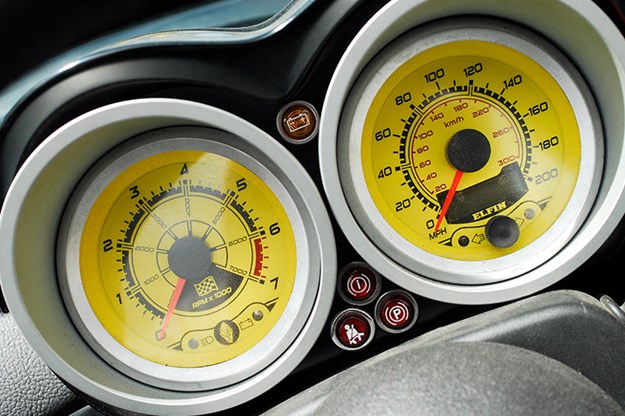
An obligatory part of any Unique Cars test is the cornering shot and this revealed another very user-friendly trait of the T5’s chassis. While the rush of power when the turbo spools up is electric, the Elfin always feels totally controllable, even at the steering lock-stops.
Drenched with VHT from the drags and coated by dust, the Calder circuit was diabolically slippery when we visited, yet while the T5 worked most of its width to satisfy Stuart Grant’s lens, we never felt like throwing it away.
Four-wheeled bike
Moving into the more confined cockpit of the SVR 200 was a familiar step back in time, but not the ultra retro Caterham experience – that is confined to the 110mm narrower and 80mm shorter Superlight models topped by the sizzling R500 that in The Stig’s hands last December dunced the Bugatti Veyron on Britain’s Dunsfold Park airfield track to become Top Gear’s Car of the Year 2008.

But the SVR is still tight – comfortably so for someone less than 180cm tall and under 80kg – but little less so for those more amply built.
First impression is that of a four-wheeled motorcycle. The almost ridiculously-small and chunky steering wheel is set low, hides most of the gauges and tweaks the Caterham as quickly as a go-kart. The dashboard is a random sprinkle of dials and switches and the vibrations from the solidly-mounted drivetrain and close-proximity exhaust are more akin to riding, than driving the beast.
The clutch is hair-trigger and tricky and even once engaged, anything but solid throttle movement in first or second gears of the close-ratio six-speed ’box can result in embarrassing bunny-hops. But once you’ve encountered third gear and beyond, the SVR 200 all comes together in a rush.

The car is alive and even on the Calder main straight, hard acceleration in fourth gear sets the R-rated 195/45-15 Avon CR500 tyres spinning. But with the lightning-fast unassisted steering, corrections are instinctive, rather than reactive. While the T5 has power to spare once its turbo comes on song, the SVR 200 somehow seems to make even more of less, with the torquey Duratec engine working in partnership with the Quaife differential to dial up attitude at will.
On the way back to Melbourne I drive the Caterham, taking considerably more care of the traffic, starts and stops. It’s not that the car is any less capable of dealing with the daily grind; it simply demands more of your attention.
Van Wyk tells me about the new SVR 120 powered by an 85kW 1.6-litre Sigma four-cylinder that Caterham Australia will soon offer as a new sub-$70,000 entry level model and the more powerful SVR 175 with its 130kW, 2.0-litre Ford engine (sub-$100,000) to expand the Australian range to three models. So effectively, Caterham will cover the Elfin catalogue.
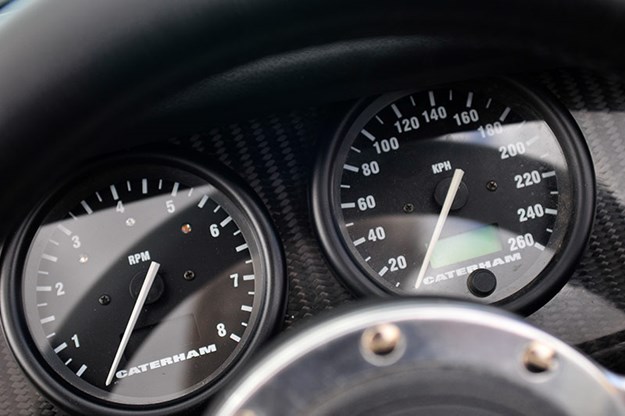
Meanwhile John Clark talks about a more Track Day-focused Club Sport version of the T5, with carbon fibre panels and stiffer suspension that may be either optioned up or marketed as a separate model for around $85,000-$90,000.
Who won?
There’s no question that Elfin will win the minds and wallets of more potential clubman car purchasers. Clark’s pre-recession estimate is for around 25 of the annual Elfin T5 production of 100 cars going to Aussies and the rest to the UK. Meanwhile Caterham Cars Australia hopes to double its current annual sales record of just three.
So, which one grabbed my heart? The T5 makes more sense. It’s locally-built, one size fits all, easier to live with day to day and the average driver will easily surprise even flagship Porsches at track days. The opening price tag of $65,000 pits it against such competition as the Mazda MX-5, Nissan’s 370Z and other worthy traditional sports cars, but there’s no disputing its bang for buck.
The Caterham SVR 200 and its replacement CSR 200 are beasts that challenge you to master. You’ll suffer in them to and from track days, stun your rivals there and enjoy driving like you never thought possible.
If it’s a car for all days and seasons, buy the T5; if it’s for those special days that really warm your heart, go the Caterham and buy a $5000 bomb for the rest of your driving!
Legend continues
Colin Chapman’s Lotus 7, launched in 1957, was immediately embraced by enthusiasts as a low-cost, lightweight sports car and successful racecar. Revised Series 2, Series 3 and Series 4 versions were subsequently launched in 1960, 1968 and 1970 respectively.

Caterham Cars, based in Caterham, Surrey, had been a major Lotus 7 dealer during the ’60s and its founder, Graham Nearn, purchased the rights to continue manufacture of the Seven design from Chapman in 1973, after Lotus announced its intention to discontinue the model.
In 1987, production and administration of the company moved to a new factory in Dartford, Kent, however Caterham Cars still retains a showroom and servicing facility in the town of Caterman.
In 2005, the company was purchased by a management buy-in team led by ex-Lotus General Manager, Ansar Ali. Today, Caterham sells more than 500 cars a year in over 15 countries.
Aussie ingenuity
Elfin founder Garrie Cooper was Australia’s Colin Chapman. At one stage in the early-’60s Elfin was the world’s second largest racing car manufacturer, but the Adelaide-built cars were lighter and even faster than the equivalent Lotus models.
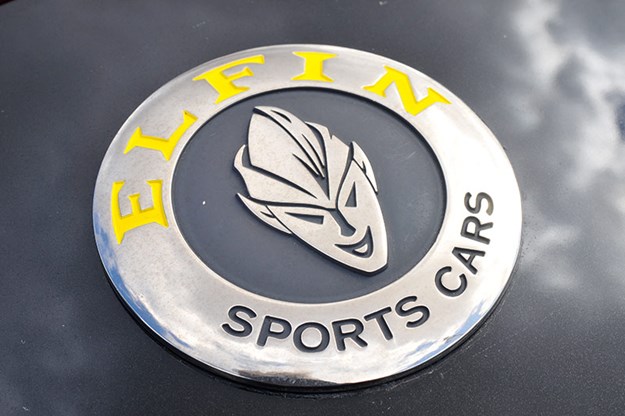
Cooper built 248 cars in 27 different models from 1958, with Elfins winning 29 national championships and major titles in his lifetime, including the Australian Formula Junior Championship, Australian 1.5 litre/Formula 2 titles, five Australian Sports Car Championships and New Zealand, Singapore and Malaysian GPs.
Winning Elfin drivers include Larry Perkins, Frank Matich, John McCormack, Peter Larner and Cooper himself.
A further 12 Formula Vee Elfins, 70 four-cylinder Clubmans and around 60 V8-engined MS8 models have been built following Cooper’s death, aged 46, in 1982.
Elfin Clubman Type 5 specs
Body/chassis: Round and square tube frame, GRP two-seater bodywork
Weight: 760kg
Engine: 2.0-litre, four-cylinder, turbo
Power/torque: 194kW @ 5300rpm/351Nm @ 2500-5250rpm
Transmission: five-speed manual
Suspension: All independent by double A-arms with combined coil spring/shock absorbers and anti-roll bars
Brakes: 298mm front/290mm rear ventilated discs with two-piston callipers
Wheels/tyres: 17 x 8.0 inch alloy/215/45ZR17 (front), 245/40ZR17 (rear).
Price: from $64,950. As tested $75,000.
Caterham SVR 200 specs
Body/chassis: Laser-welded tube chassis, alloy two-seater bodywork
Weight: 630kg
Engine: 2.3-litre, four cylinder
Power/torque: 147kW @ 7000rpm/214Nm @ 5850rpm
Transmission: six-speed manual
Suspension: Independent fully-adjustable by wishbones and coil-over shock absorbers (front); semi-independent De Dion with coil; springs and shock absorbers (rear). Adjustable front and rear anti-roll bars
Brakes: Four-wheel AP disc, 254mm diameter (front), 230mm (rear)
Wheels/tyres: 15 x 6.0 inch/195/45VR15
Price: $119,000.
Unique Cars magazine Value Guides
Sell your car for free right here
Get your monthly fix of news, reviews and stories on the greatest cars and minds in the automotive world.
Subscribe

.jpg)









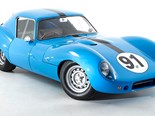
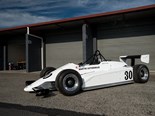
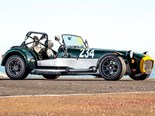

.jpg)
